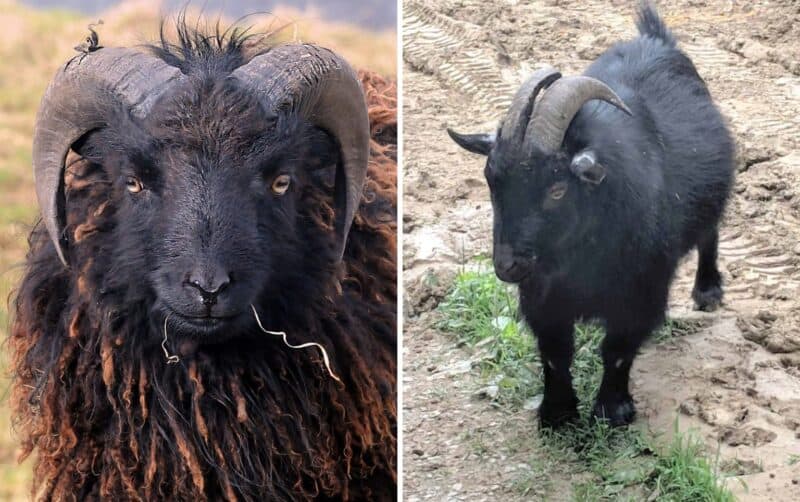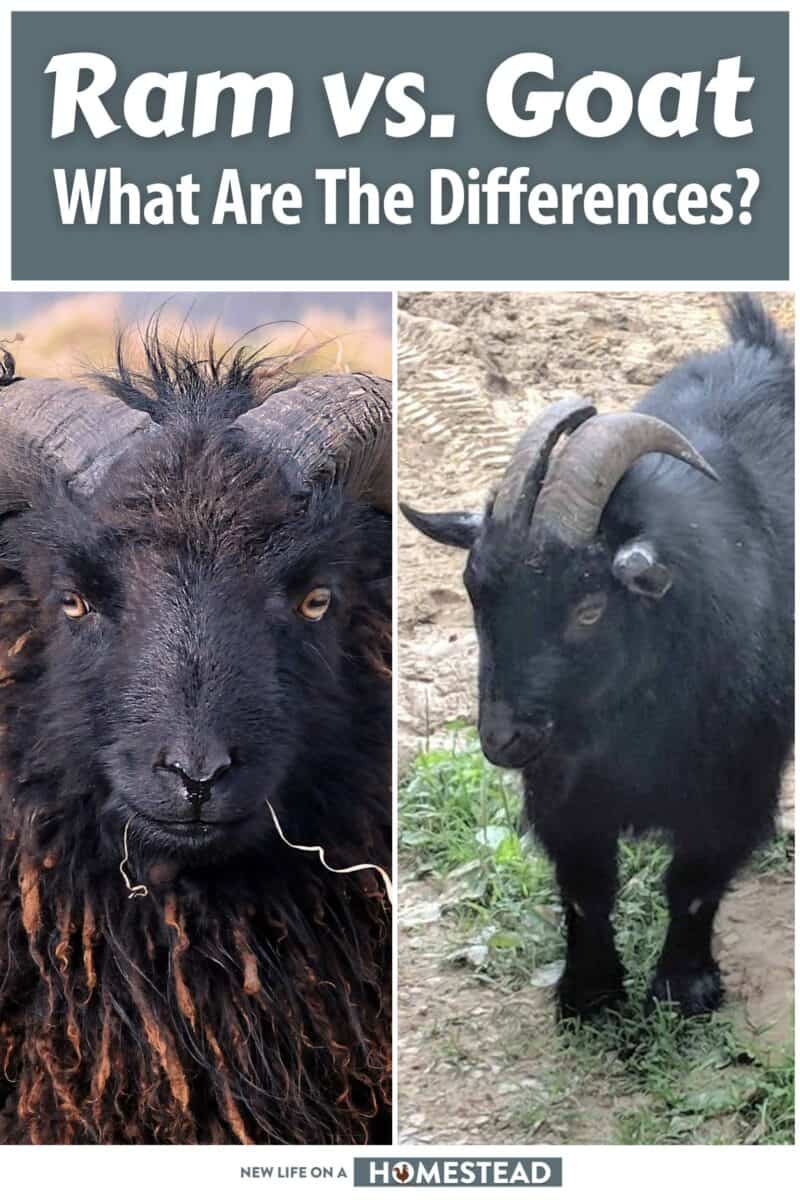When it comes to domestic animals, most species look quite different but not all. It’s common to confuse a donkey with a horse, and sometimes ducks and geese can be mixed up… But other times the differences can be very minimal indeed.

Let’s compare rams and goats, for instance. They’re about the same size, both usually have horns, and both have those weird rectangular pupils that are so unsettling.
They even make similar sounds! So, we’ve got to figure this out: what are the real differences between rams and goats?
Rams and goats are two completely different species. Rams are male sheep, while the term goat could include male or females of that species. There are differences in the body shape and horns, and particularly between the wool of rams and the fur of goats.
While it is true that members of each species can look quite similar, there are enough differences to make it pretty easy to tell them apart once you know what to look for.
In any case, I think that people mostly get them mixed up as a matter of terminology.
If you’re one of those people, don’t worry, I’ll tell you about all the differences down below in the rest of this article.
Table of Contents:
Are Rams and Goats Different Species?
The answer is yes: rams and goats belong to different species despite their outward similarities.
Rams are male sheep, and they belong to the species Ovis aries, while goats belong to the species Capra hircus.
Although both animals are quite similar, outwardly, they have several physical and behavioral differences that set them apart.
Rams are Male Sheep
Rams are simply male sheep, concerning wild and domestic sheep alike. They are known for their often impressive horns which can grow up to three feet long in some breeds.
Rams tend to be larger than female sheep and are more territorial and aggressive, especially during breeding season.
But domestically, rams play an important role in sheep farming as they are used for breeding purposes.
They can also used to produce the same, high-quality wool females produce which is used in the production of clothing, blankets, and other textiles.
In some cultures, rams are considered a symbol of strength and masculinity, and their horns are often used as decorative or practical elements in crafting.
Male Goats are Called Bucks or Billies
Male goats are called bucks or billies; hence billy goat! Also known for their distinctive horns which can vary in size and shape depending on the breed.
Like rams are to sheep, male goats are usually larger and more muscular than female goats, and they can be infamously foul-tempered and easy to anger, especially when around females during the rut!
Male goats, and all goats generally, similarly play an essential role in agriculture as they are used for meat, milk, and fiber production.
Goat milk is richer in nutrients than cow’s milk and it’s used to make a variety of dairy products like cheese, yogurt, and ice cream.
Are Rams and Goats Different Sizes?
Rams and goats can vary significantly in size depending on age and most especially concerning the breed, though rams overall tend to be larger than goats, with males easily weighing up to 350 pounds or more, and some monster breeds clearing 425 pounds.
In contrast, adult male goats usually weigh between 125 and 225 pounds, and females typically weigh between 75 and 150 pounds.
The size difference between the two animals is due to their distinct evolutionary paths.
While most rams evolved to live in colder climates, which required them to be larger to survive, most goat breeds developed in a warmer climate where they needed to be lighter and more agile.
Rams Have Wool, Goats Have Fur or Hair
One significant difference between rams and goats, and one that is highly likely to help you tell them apart at a glance, is the type of hair or fur they have.
Rams have wool, which is a thick, curly or wavy coat. Highly distinctive in appearance, it is this wool that keepers and farmers shear for use in textiles like clothing, blankets, and carpets.
The wool of a ram helps to keep it warm in colder climates, as well as protecting it from predators to a degree.
On the other hand, goats have proper fur or hair, which is usually straight, thinner and much coarser than wool.
Goat hair is usually shorter than wool, too, though it is also used to make a variety of products, including clothing, rugs, and certain brushes.
Both Rams and Goats Can Be Highly Aggressive
Despite their sometimes cute and goofy appearance, both rams and goats can prove to be highly aggressive animals, especially during the breeding season or when they think they need to protect their respective herd or flock- including from people!
During this time, males can become territorial and edgy, making them more likely to attack any other animals or humans who come too close.
Some domestic rams and many goats have hard, sharp horns that they use for fighting and defense.
These horns can cause serious injuries, so it’s essential to be cautious around these animals, and not underestimate them!
A charge and headbutt from a large specimen of either species could send you to the ER.
Do All Rams and Goats Have Horns?
The assumption that all rams and goats have horns is not entirely true… Some rams and many goats have the ability to grow horns, but not all individuals of these species do so.
Horn growth is influenced by several factors, including breed, genetics, and sex.
In general, males of both species are more likely to grow horns than females. However, some breeds of sheep and goats have been selectively bred to be hornless, known as polled, which means they lack the gene for horn growth.
Polled sheep and goats are popular in farming as they are less dangerous when they act up and easier to handle than horned animals.
Also, some breeds that do have horns might have their horn growth eliminated when they are young through a process called disbudding, where the horn buds are removed from a lamb (baby sheep) or kid (baby goat) shortly after birth.
In other breeds, especially wild ones, males and females alike might have horns though invariably males have larger, sturdier and more dangerous ones.
Rams and Goats Behave Quite Differently
Rams and goats have different behaviors that likewise reflect their distinct evolutionary paths. Rams, and all sheep, tend to be more cautious, timid and flock-centric.
They are usually content to follow the lead of a dominant individual whenever they are in a group and stay closely packed together unless there is a good reason to separate.
In contrast, goats are generally more curious and adventurous than rams. They are also excellent climbers, far better than domestic sheep at least, and can navigate rough terrain or bound over obstacles with ease.
Goats are also known to be more independent than sheep, preferring to live in smaller herds and exploring their surroundings alone far more readily – the better to find choice foods!
Rams and Goats Have Very Different Diets, Too!
Diet is another area where rams and goats differ significantly. Rams, and all sheep, are grazers, meaning they eat grass and other low-growing vegetation.
Their digestive systems are well-suited to break down consistently eaten plant material like grass, which makes up the majority of their diet.
Goats, on the other hand, are browsers, meaning they prefer to eat leaves, bark, and twigs from trees and shrubs along with a variety of other plant matter.
They have a more flexible digestive system that allows them to digest a wider variety of foods than rams and other sheep.
Is Ram or Goat Meat Better?
That is a question with many variables. Generally, sheep meat, which may be mutton or lamb, is much better than goat, sometimes called chevon.
That is because some sheep are typically bred for meat production, while goats may be used for other purposes like milk or fiber.
As such, the meat from a well-bred and well-fed ram or lamb is usually of higher quality than that of a goat.
In all cases, lamb, the meat from a yearling or younger sheep, is much better than that of comparable mutton, meat from an older adult sheep.
That said, some people prefer the taste and texture of goat over that of sheep. It has a stronger, gamier or funkier flavor than lamb, but when prepared properly, it can still be milder than older mutton.
Goat meat is often served in stews, curries, shawarma, gyros, tacos, etc., as it can stand up and be better served by strong spices and cooking styles.
Both are certainly edible, and both have a good culinary history, but ultimately, it comes down to personal preference!

Tom has lived and worked on farms and homesteads from the Carolinas to Kentucky and beyond. He is passionate about helping people prepare for tough times by embracing lifestyles of self-sufficiency.
